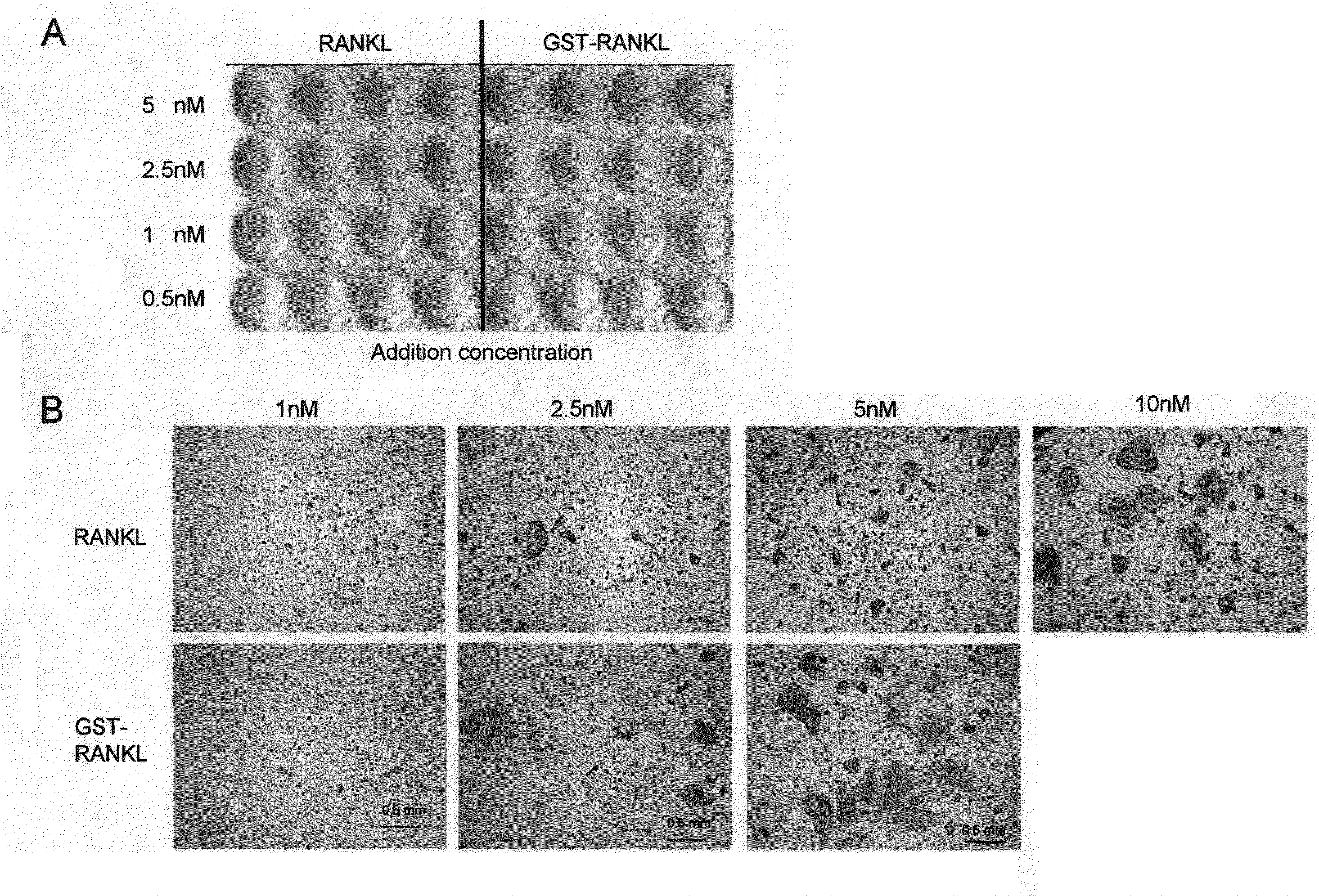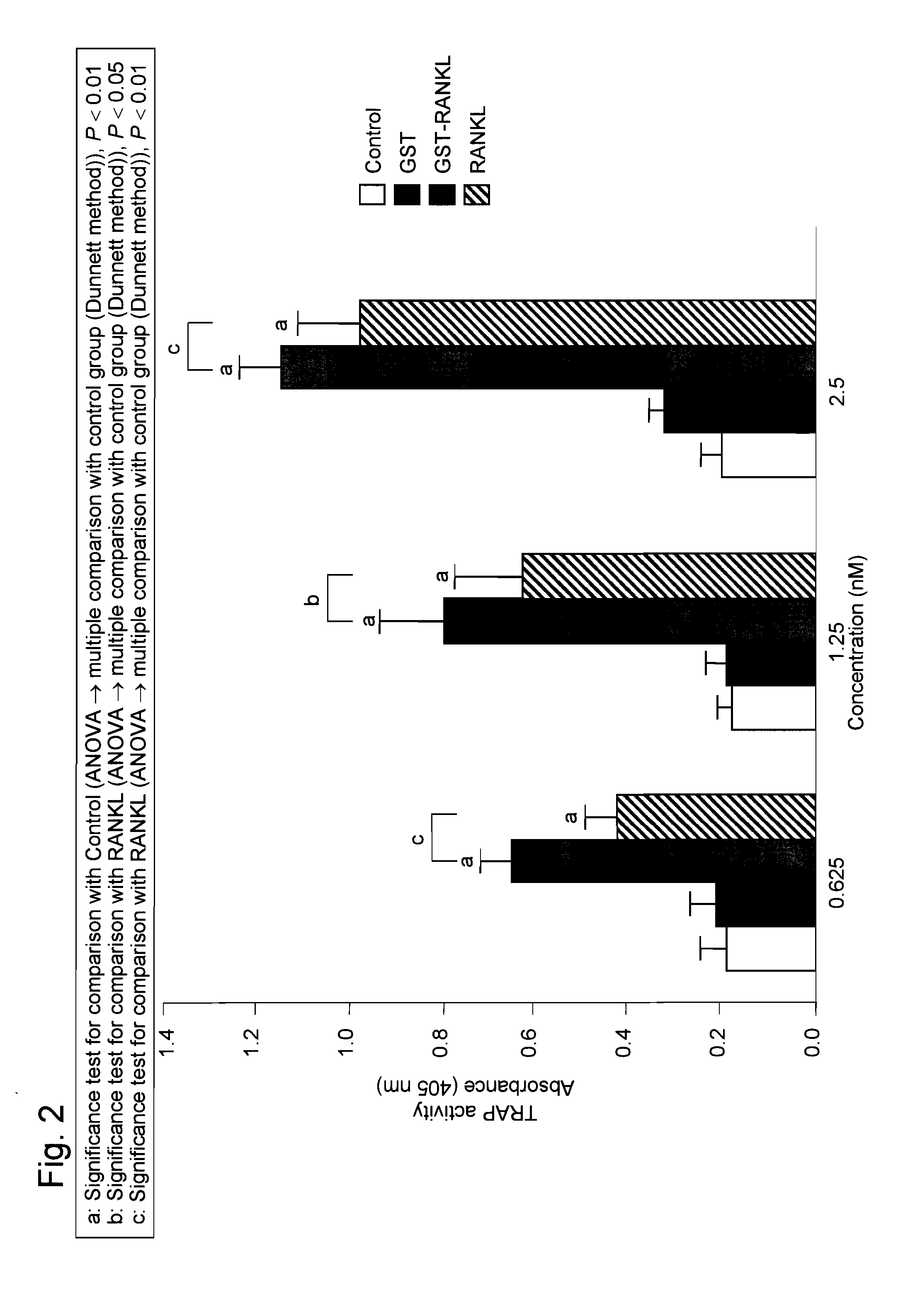Agent containing fused protein of soluble rankl with epitope tag
- Summary
- Abstract
- Description
- Claims
- Application Information
AI Technical Summary
Benefits of technology
Problems solved by technology
Method used
Image
Examples
example 1
Confirmation of In Vitro Effects of GST-RANKL
Preparation of GST-RANKL
[0060]SalI and NotI sites were added to cDNA encoding human RANKL residues 140-317 by PCR. The resultant was cloned downstream of Glutathione S-transferase of pGEX-4T-2 (GE healthcare; Genbank Accession Number: U13854) with the use of the endonucleases. Protein expression was induced in BL21 (DE3) Escherichia coli (Invitrogen) with IPTG (final concentration: 0.5 mM). Then, bacterial cells were suspended in an extraction buffer (50 mM Tris-HCl (pH 8.0), 100 mM NaCl, 1 mM EDTA, 1 mM DTT, and 1% (v / v) TritonX-100) and pulverized at 4° C. with the use of a sonicator. After centrifugation at 18000×g for 15 minutes, the supernatant was recovered and applied to a Glutathione Sepharose column. Subsequently, washing with a washing buffer (50 mM Tris-HCl (pH 8.0), 100 mM NaCl, 1 mM DTT, 0.1% (v / v) TritonX-100) was carried out, followed by elution with a Glutathione solution (20 mM reduced glutathione and 50 mM Tris-HCl (pH 8...
example 2
Confirmation of In Vivo Effects of GST-RANKL
[0068]GST-RANKL was prepared in the same manner as in Example 1.
RANKL Administration Test
[0069]GST-RANKL or soluble RANKL (Peprotech) was administered 3 times via an intraperitoneal route to groups of 7-week-old female C57BL / 6N mice (10 individuals each) at doses of 57 nmol (low dose) and 426 nmol (high dose) every 24 hours. Exsanguination was performed 1.5 hours after the third administration. A group to which PBS was administered in the same manner as above was used as a control group for comparison.
[0070]The exsanguinated blood was subjected to measurement of serum bone resorption parameters (calcium, CTx (type I collagen-crosslinked C-peptide telopeptide), TRAP-5b) and serum osteogenesis parameters (osteocalcin and alkaline phosphatase (ALP)). Calcium was measured by the OCPC method (WAKO, 272-21801). CTx (Nordic Bioscience Diagnostics), TRAP-5b (IDS Ltd, SB-TR103), and osteocalcin (Biomedical Technologies Inc.) were measured by ELISA....
example 3
GST-RANKL Activity
[0076]GST-RANKL and soluble RANKL (produced by Peprotech) were separately added to RAW264 cells at serially diluted concentrations of 10, 5, and 2.5 nM. 4 days later, the TRAP activity was determined by the method described in Example 1. The osteoclast differentiation activity after the addition of soluble RANKL (10 nM) was already at the saturation level, and thus the activity did not increase at higher concentrations. As described above, it has been found that soluble RANKL is inferior to GST-RANKL, and that GST-fused RANKL exhibits improved activity and enhanced potency inherent in RANKL such that GST-RANKL exhibits osteoclast differentiation and activation effects to an extent that cannot be achieved with the addition of RANKL alone (FIG. 10A). In addition, osteoclasts in the above case were microscopically observed. Accordingly, GST-RANKL was found to induce osteoclasts larger than those induced by soluble RANKL (FIG. 10B).
GST-RANKL Preservation Stability
[0077...
PUM
| Property | Measurement | Unit |
|---|---|---|
| Reactivity | aaaaa | aaaaa |
| Stability | aaaaa | aaaaa |
Abstract
Description
Claims
Application Information
 Login to View More
Login to View More - R&D
- Intellectual Property
- Life Sciences
- Materials
- Tech Scout
- Unparalleled Data Quality
- Higher Quality Content
- 60% Fewer Hallucinations
Browse by: Latest US Patents, China's latest patents, Technical Efficacy Thesaurus, Application Domain, Technology Topic, Popular Technical Reports.
© 2025 PatSnap. All rights reserved.Legal|Privacy policy|Modern Slavery Act Transparency Statement|Sitemap|About US| Contact US: help@patsnap.com



